Updated 12/14/25. Retinoids are derivatives of vitamin A that can improve and even reverse the visible signs of aging—including lines, wrinkles, post-breakout marks, large pores, and brown spots. It doesn’t matter whether they’re in a prescription form (tretinoin) or a non-prescription form (retinol). With continued use, they can dramatically improve the appearance of the skin, helping it mature in a more desirable way.
However, if you use a retinoid, you must take special care of your skin to manage potential side effects. This is especially true if you’re using a prescription formula, though dryness and irritation can appear with any retinoid product. If misused, the effects are often intolerable. I once had a client who was using a prescription retinoid improperly. As she was talking to me and complaining about her skin, one of her nasolabial folds (laugh lines) cracked and started bleeding right in front of my eyes. It was crazy!!!
Luckily, the side effects are completely manageable, and sometimes, even avoidable. You just need to know what to do. Keep reading to learn how to safely and properly incorporate retinoids into your skincare routine.
The Different Types of Retinoids
There are many different types of retinoids—retinol is just one of them. Each one is of different strength and comes with its own set of pros and cons. What they all have in common is that they’re derived from vitamin A and they convert to retinoic acid in the skin. From there, they increase cell thickness, affect gene expression, encourage skin resurfacing, and increase collagen production.
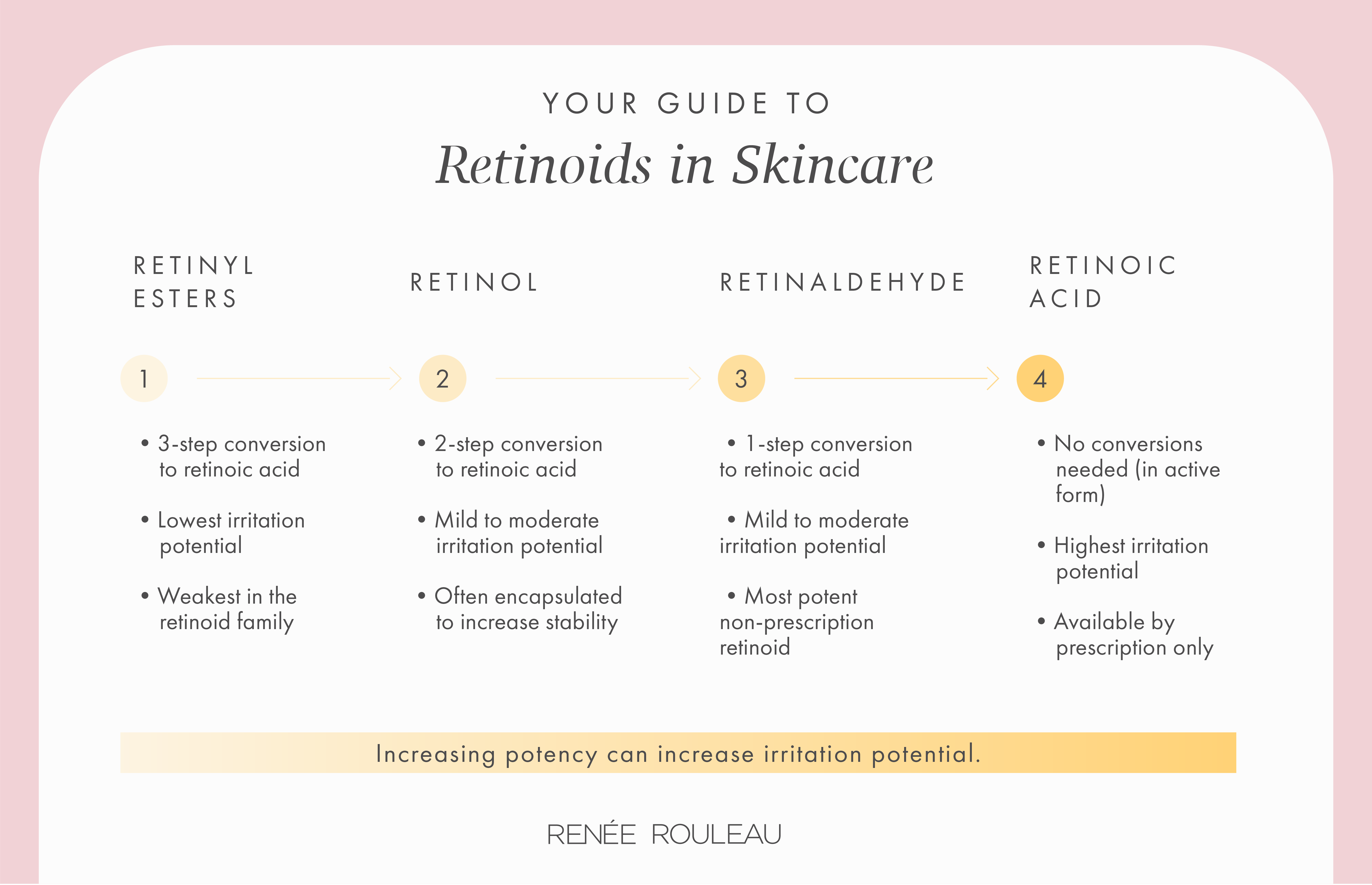
How to Tell If You Should Use a Prescription Retinoid
I don’t recommend starting with a prescription retinoid. These are potent and difficult to tolerate, especially if you’ve never used retinoids before. Instead, I recommend starting out with a less potent retinoid, like retinol, and working your way up from there.
With that said, there are certain cases when the skin needs something stronger than a non-prescription retinoid. In my experience, I believe prescription retinoids are best suited for those who have one or more of the following:
- Post-breakouts marks and scars
- Clogged pores
- Enlarged pores
- Sun damage
- Fine lines and wrinkles
- Minimal skin sensitivity
Generally speaking, if you’re over the age of 35 and you’re looking to get serious about skin aging, I suggest using a prescription. Again, you can always start with a less potent form and work your way up to a prescription.
When to Start Using Retinoids
I generally recommend starting to use retinol between the ages of 25 and 30 for preventive skin aging. The exact age will depend on your specific skin type, although I don’t suggest starting it before 25. There are two reasons for this. The first is that many people who are younger than 25 are still dealing with breakouts. Despite what you may have heard, retinoids do NOT help cystic or pustular acne. However, prescription retinoids CAN be effective for managing closed comedones (more on that in a minute).
The second reason is that vitamin A speeds up the skin’s metabolism, which slows with age. When you’re younger, your skin is already metabolically active. Using retinoids too early could backfire and stir up breakouts, rashes, and more.
What to Know Before Using Retinoids
1. Retinoids Aren’t Recommended for Use During Pregnancy
Of course, it’s always best to consult your doctor. In my experience, though, most advise against using vitamin A ingredients until after giving birth, due to potential risks. I have not personally come across any reported evidence of retinoids causing harm, but doctors are extra cautious with expecting mothers, and understandably so.
2. Proper Sun Protection Is Critical
You can use retinoids in the summer. However, since they make your skin more sensitive to the sun and more vulnerable to damage, proper sun protection is of the utmost importance.
If you know you’re going to be spending a lot of time in the sun (like if you’re planning a beach day for instance), I suggest discontinuing your retinoid seven days before the intense sun exposure. Start it back up again a week after you’ve been in the sun—assuming you don’t have a sunburn, of course. While this will slow down results, it’s super important to prevent skin inflammation and irritation.
But in general, you want to use it year-round. However, if you feel like a prescription is too irritating in the summer because you’re spending time in salt water or chlorine, then dial it down to a gentler formula like this one.
3. Retinoids Work Slowly and Steadily
I always say that using retinoids is a marathon, not a sprint. They won’t deliver immediate results. In fact, they work incredibly slowly. Stick with it, though, and eventually, you’ll see results. Trust me on this, it’s s0 worth it to be patient!
4. Prescription Retinoids Travel Underneath the Skin
Some people apply prescription retinoids strategically in an effort to target a specific area. For example, someone might apply it only around their eye area. They think this will address eye wrinkles while sparing the rest of their face from dryness. In reality, prescription retinoids travel underneath the skin. Even if you apply it strategically, it will affect your entire face, which means you can experience dryness anywhere on your face.
Retinoids and Acne
It’s true that prescription retinoids were originally developed in the ’70s for treating acne. It wasn’t until later that dermatologists discovered it could also help with aging. That explains why, for a long time, retinoids had the reputation of being a go-to for all kinds of breakouts. However, that’s not totally accurate.
The Types of Breakouts Retinoids Can Improve
In my experience as an esthetician, the type of acne that prescription retinoids work best for is comedonal acne. This is the type that appears as whiteheads, blackheads, closed comedones, and non-inflamed bumps. Since they reorganize skin cells through cellular turnover, they can prevent cells from becoming trapped in the pores and forming blemishes.
I’ve found that retinoids do not work for sore, inflamed pustular acne or cysts. In fact, when someone has infected pustular and cystic acne, retinoids may actually make them worse by causing irritation.
What to Do If Breakouts Are Your Main Concern
If red, inflamed breakouts are your main concern, I usually advise clearing these before starting retinol. Once your skin is clear, you can incorporate a retinoid product to prevent visible signs of aging.
With that said, if bumpy skin caused by clogged pores is your main concern (not inflamed breakouts) there’s now a 1% Differin gel available without a prescription. It’s worth adding to your routine to see if it helps.
One more note on retinoids and breakouts. I suggest using an exfoliating acid serum a fews nights a week on nights you’re not using the retinoid. This will increase the retinoid’s efficacy. Check out these acid exfoliators. Take this Skin Type Quiz to see which formula is best for you.
How to Introduce Retinol Into Your Routine
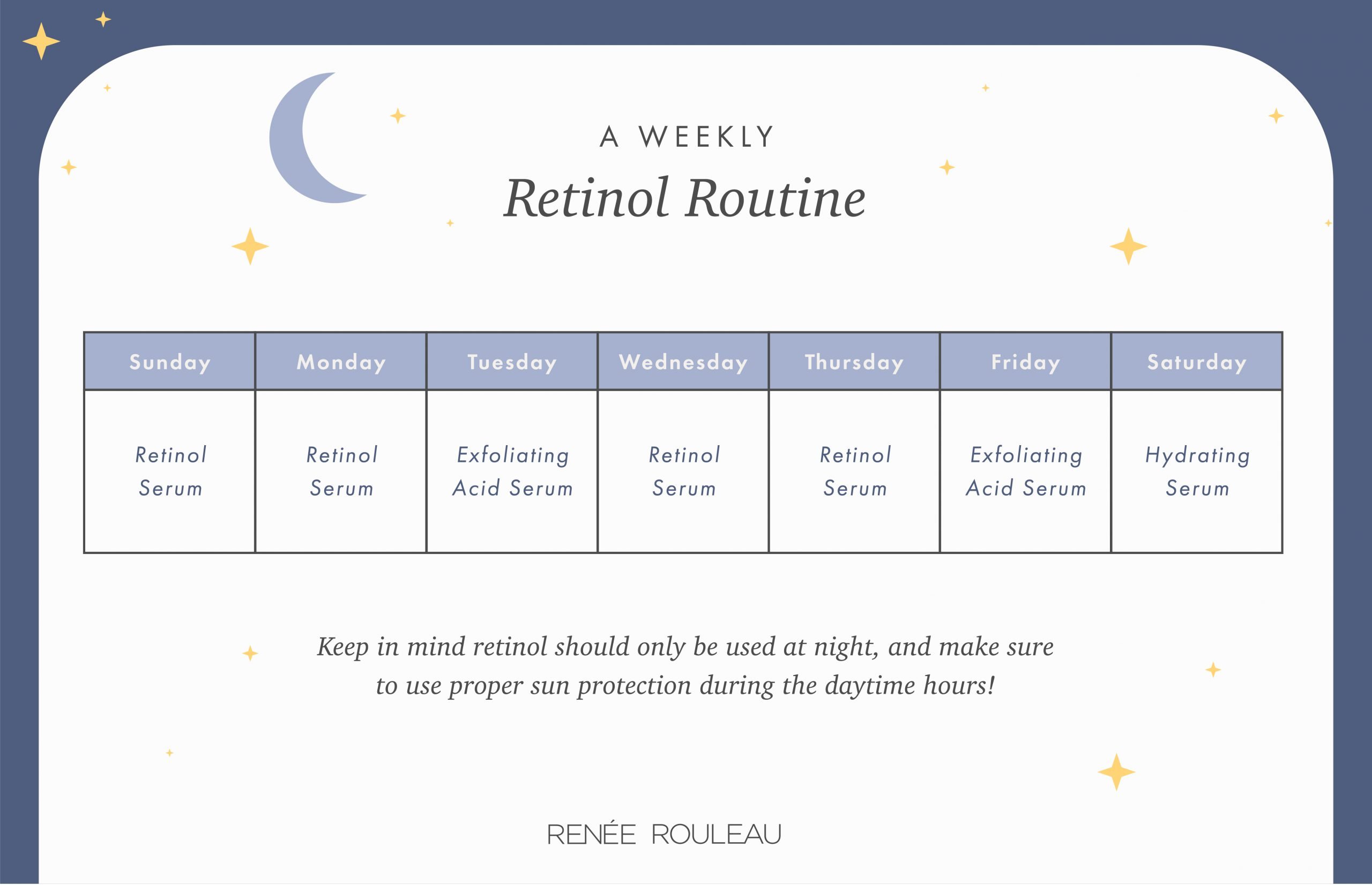
As I said before, if you’re new to retinoids, start with a non-prescription version, such as retinol. To reiterate, the reason is that most people who start with a prescription (without proper usage instruction) eventually give up because their skin becomes too dry and irritated.
If you have a prescription and haven’t been able to use it successfully, consider putting that on hold for now. Start with non-prescription retinol, like the Advanced Resurfacing Serum. This is the retinol product that I personally use. It’s also the one I recommend to my clients. It combines stable retinol with skin-firming peptides.
Start by Using Retinol 2 Nights On and 1 Night Off
Repeat this throughout the week. For best results, you must use retinol consistently (and often!).
Your skin has other needs, though, so you don’t want to use it every single night. Plus, using it too often could prove too much for your skin, since it’s such a biologically active ingredient.
Following the two nights on, one night off rule will result in four nights a week. If you are over 40 with a history of sun damage and your skin isn’t overly sensitive, you can use it four to five nights a week. However, no one should use it for more than five nights a week. This can eventually result in increased sensitivity and a waxy and unnatural appearance.
On the other hand, if you’re under 40 and your skin is fairly sensitive, you might start by using it only twice a week. Then after two months, you can work up to using it three nights a week. Eventually, try to work up to four nights a week.
When in doubt, start slow and increase as you go along. If you’re experiencing dryness or irritation, you’re either using too much or using it too often. This is a sure sign that you should cut back.
Don’t Apply Moisturizer Right After Retinol
This may slightly dilute the retinol. It’s best to let it absorb for two minutes. Or, you can use a retinol serum that has a lotion-like texture. This can offer hydrating and protective benefits, thus skipping the need for moisturizer altogether.
Use an Exfoliating Acid Serum on Opposite Nights
This is really important. Retinol encourages dull, sun-damaged skin cells to rise to the surface for easy removal. Using a gentle exfoliating acid serum once or twice a week will accelerate removal. The retinol can then absorb more easily. Using both will result in a smoother, more even-toned texture.
Use a Hydrating Serum 1-2 Times a Week
The skin requires a variety of ingredients. Therefore, you don’t want to constantly stay in exfoliation and cell turnover mode by using only retinol and exfoliating acids. Treat it to a hydrating serum that contains antioxidants, peptides, or epidermal growth factors once a week.
Think of it just as you would your exercise routine. When working out, it’s best to alternate between various types of exercise, so you get a little bit of everything. Your skin appreciates the same variety.
Get a Professional Chemical Peel to Boost Results
Once you’ve been on your new retinol routine for two months, it’s time to kick it up a notch. Introduce your skin to a chemical peel—whether a professional peel or an at-home peel. It will intensify your skin’s collagen-boosting activity to encourage faster results. Synergistically, both retinol and chemical peels support one another to achieve smoother, more even-toned skin.
There are many types of peels, so you’ll want to consult a trusted esthetician to find out which type and what frequency is best for your skin. I generally recommend light to medium chemical peels 3-4 times a year. You can get lighter peels every other month.
Note: If you want to use a prescription retinoid, introduce it after six months. Of course, you’ll have to consult a doctor about this. Your doctor can tell you what’s best for you and your specific skin goals. Generally speaking, you should start with the lowest strength.
How to Introduce a Prescription Retinoid Into Your Routine
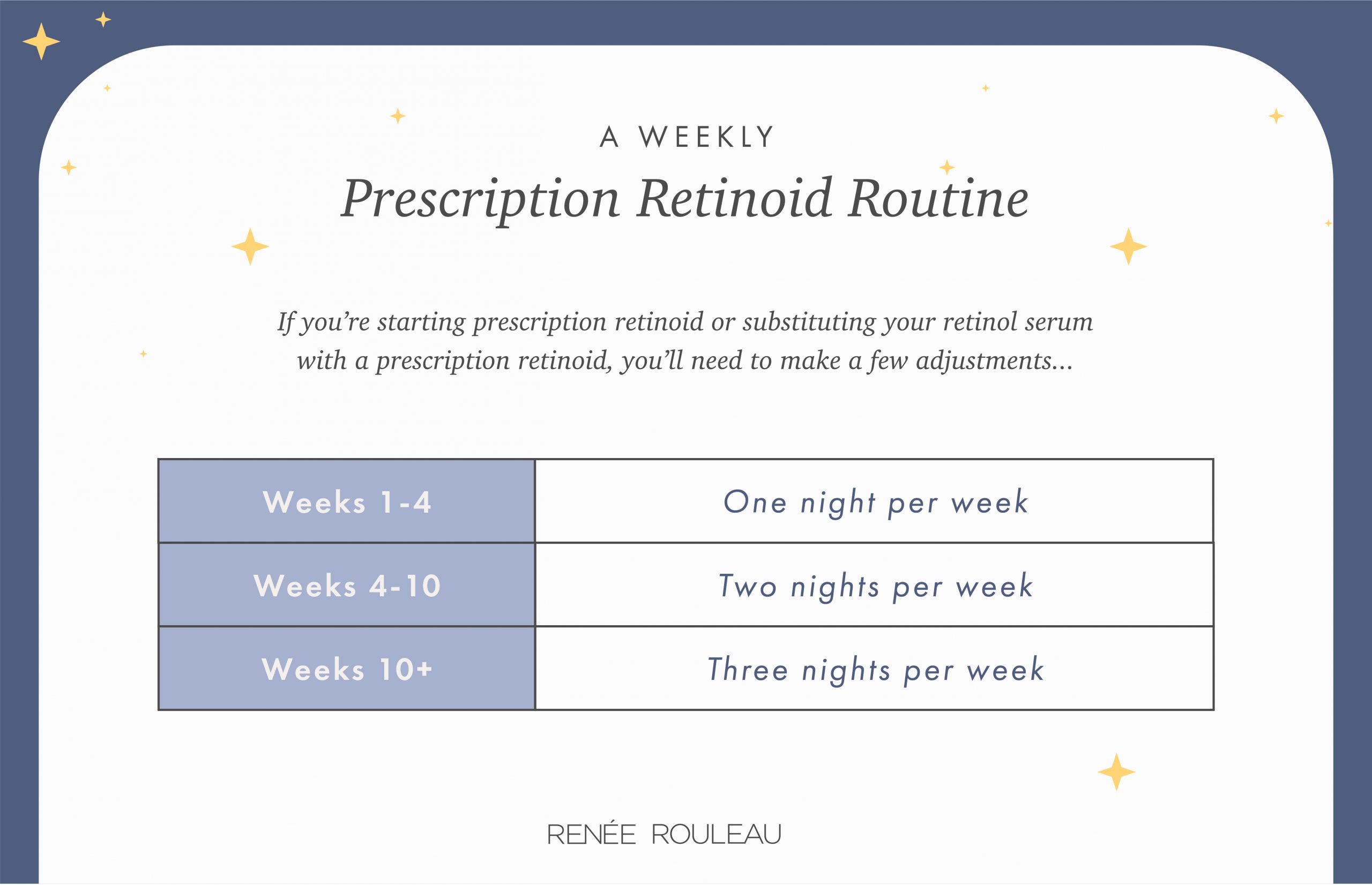
This is assuming you started with a less potent, non-prescription retinoid, such as retinol. After six months of use, and if your skin tolerates it well, you can begin to slowly introduce a prescription retinoid.
Weeks 1-4: Substitute Your Retinol with a Prescription Retinoid 1 Night Per Week
After cleansing, apply an alcohol-free toner. Leave it damp, then apply a thin layer of a lightweight moisturizer to the skin before applying your retinoid. The moisturizer cannot be heavy or greasy. Wait five minutes and apply a pea-size amount of the prescription retinoid to your entire face. (I recommend treating the neck and chest with retinoids, too. Use an extra pea-sized amount for this area as well.)
Let it dry for 20 minutes and follow with more moisturizer. This time, you can use your normal moisturizer. Ideally, use one that supports the skin’s moisture barrier to keep sensitivity to a minimum.
There has been a lot of discussion about whether or not using a moisturizer underneath a retinoid affects its performance. Most believe that it does not interfere. Instead, the right moisturizer can keep your moisture barrier intact. This is the secret to making a prescription retinoid tolerable.
I always recommend Sheer Moisture Lotion to my clients due to its light texture and antioxidant ingredients. Retinoids can cause “micro-wounding” in the skin, and antioxidants help stop the resulting inflammatory response.
Weeks 4-10: Substitute Your Retinol with a Prescription Retinoid 2 Nights Per Week
Think of your prescription retinoid as a workout for your skin. You don’t want to lift the heaviest weights on day one. Instead, you want to take it slow and gradually build up to it over time.
Weeks 10+: Substitute Your Retinol with a Prescription Retinoid 3 Nights Per Week
For most people, I suggest sticking with this routine for the long run. You’ll alternate nights between your original retinol serum (eventually you can drop this), a prescription retinoid, an exfoliating acid serum, and a hydrating serum. They’ll work synergistically to improve the look of your skin.
If you have very sun-damaged skin, you may want to increase the prescription retinoid to four nights a week after six months of use. Also, consider upgrading to a new one with a stronger percentage.
I do, however, discourage people from using it too frequently. Over time, this can cause the skin to appear tight, shiny, and waxy. I can spot someone who is overusing prescription retinoids a mile away. It just doesn’t look natural.
The Bottom Line
Retinoids can be intimidating to introduce into your skincare routine, especially when you consider the potential dry, flaky side effects. However, if you give your skin some TLC, you can successfully incorporate them.
I’ll leave you with one last thought. As I mentioned previously, using a retinoid is a marathon, not a sprint. It can take a while to see results, and you won’t get immediate gratification. To reap its benefits, without incurring dryness or irritation, you must deliver a slow drip to the skin. I recommend using it regularly for the rest of your life…or until a better anti-aging product takes its place! And if that’s the case, I’ll be sure to let you know. For now, head on down Retinol Road.
Next, learn the 4 most important things to look for when choosing a retinol product.
Celebrity Esthetician & Skincare Expert
As an esthetician trained in cosmetic chemistry, Renée Rouleau has spent 35 years researching skin, educating her audience, and building an award-winning line of products. Her hands-on experience as an esthetician and trusted skin care expert has created a real-world solution — products that are formulated for nine different types of skin so your face will get exactly what it needs to look and feel its best. Trusted by celebrities, editors, bloggers, and skincare obsessives around the globe, her vast real-world knowledge and constant research are why Marie Claire calls her “the most passionate skin practitioner we know.”

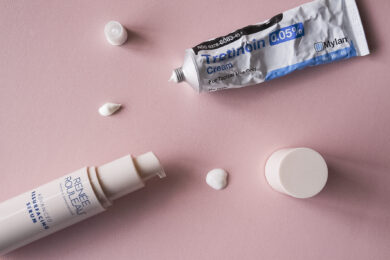
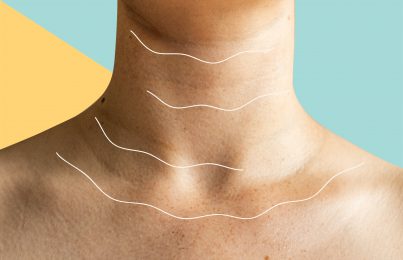
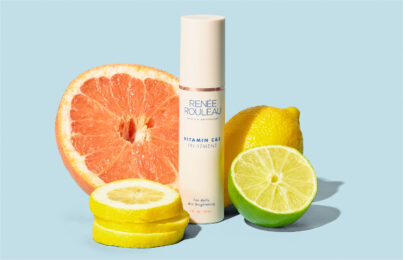
Comments:
Hi.. what is your opinion for people younger than 26 years old to use moisturiser that contains retinol for day cream? If the people does not have any breakout or acne problem.
Posted By: Adnin |
Hi there! I wouldn’t ever recommend using a day cream with retinol, no matter what age. To learn why retinol is a nighttime ingredient check out this blog post! https://blog.reneerouleau.com/can-you-wear-retinol-during-the-day/
Posted By: Renée Rouleau |
Hi! I just purchased your Resurfacing serum. I also purchased your overnight serum firm and repair. Can I use these two together on the same night or do I switch back-and-forth? By the way I am obsessed with your luxe meant cleansing gel! It is the best facial cleanser I have ever used:) thanks so much
Claudine
Posted By: Claudine |
I am so glad the products are giving you the results you have wanted. Ideally, you will use the Advanced Resurfacing Serum two nights in a row and the Firm + Repair one night. Continue alternating serums. Be sure to use your Overnight Eye Serum on a night you use Firm + Repair.
Posted By: Renée Rouleau |
How about the morning routine? Should I keep using my vitamin c or other antioxidants before my spf, while on Prescription Retinoid use? Thank you in advance 🙂
Posted By: Sofia Tavares |
Yes! When using retinoids sun protection becomes even more important. Check out this blog post to make sure your vitamin C meets your needs. https://blog.reneerouleau.com/vitamin-c-for-retinol-users/
Posted By: Ella Stevenson |
Hi Renee,
I’ve been looking at your products and reading your blogs for some time now. A few years ago, I purchased your Anti Cyst Treatment summer of 2018 to use on the cyst I had that wouldn’t go away. I finally had to have it injected with a steroid. That cyst seemed to be the start of my skin issues since my early 30’s.
I am 49, soon to be 50 years old. I have fair skin that can be sensitive. I broke out with cystic acne (just one at a time, but very large, red and painful) in my early 20’s and early 30’s. In my mid 30’s I started using Proactive. I used their original products for awhile and then switched to using their Gentle Formula Cleanser (Salicylic Acid) and Toner (Glycolic Acid), Repairing Treatment (Benzoyl Peroxide) and either their Green Tea moisturizer or Moisture Repair. This system, as crazy as it sounds worked for years. A little over a year ago, they changed the ingredients of the Gentle Formula cleanser (horrible consistency and smell), so I had to start looking for a new one. I stumbled across Dermalogica and started using some of their products last spring. The esthetician I saw said my skin was very sensitized and dehydrated. After trying several of their products, I am currently using their Ultra Calming Cleanser morning and night, Daily Microfoliant mixed in with the cleanser only at night and Ultra Calming Mist in the morning. I am also using Proactive’s Gentle Formula Day lotion/moisturizer (2% Salicylic Acid) after toning in the am and their Gentle Formula Night Cream (1% Salicylic Acid/Retinol/Retinol Palmytate). I use Dermalogica’s Prisma Protect sunscreen. I am now also on Spironolactone for monthly cysts. I have been on that since last September. That really seems to be helping and I haven’t had any cysts since October. However, I still have some tiny under the skin bumps on the right side of my chin that nothing seems to make go away. They’re not that noticeable or cause any pain… There just there. I also have some on my left cheek and temples. I am a teacher, so I wear makeup during the school year, but not in the summer. I prefer not wearing makeup because it just feels like too much on my skin. My skin doesn’t seem to “absorb” very well. For the most part, lotions and serums feel as if they just sit on the surface of my skin and have a “tacky” feel. I know… I am truly a hot mess and most likely every esthetician’s night mare!
The past few weeks, I have been looking at Skin Types 4, 5 and 6 as it seems I’m a bit of all 3. My face tends to get red/flushed at certain times of the month. Now that I’m on Spironolactone, the cysts seem to be under control, but I want to make sure I’m doing what’s right for my skin.
I feel that the Proactive products with Glycolic acid, Salicylic acid and retinol (the little that is in the Night Cream) have been helping, but have been looking at your serums as an alternative. Currently, I have the Advanced Resurfacing Serum, Pore +Wrinkle serum, Firm + Repair serum, Weightless Protection and Hydraboost Rescue Cream in my cart. While I’m not opposed to spending money for good products, I’m just not sure I can spend that much at this time. I just want the right products for my skin. I’m a bit nervous, since I’m not able to see any reviews and you have a no refund policy.
With all this being said, I could really use some advice! I value your opinion and look forward to hearing from you!
Posted By: Tish Douglas |
Hello! I’m sorry to hear you’re experiencing some dehydration and continued breakouts. You sound like a perfect candidate for a virtual consultation! Virtual consultations connect you with a listened esthetician to talk about your skin’s concerns and needs. They will assign you with a skin type number and create a custom routine for you. Normally consultations are $100, however that fee is waived when you purchase $100 worth of product during your appointment. You can learn more and book here: https://www.reneerouleau.com/pages/spas-virtual-consultations
Posted By: Ella Stevenson |
I’m so depressed because I think I forever damaged my face with retinol. After using the Sunday Riley A+, I now have visible pores all over my face and when I smile the pores connect to form lines that make me look extremely old. I’ve read countless blogs where this has happened to others and no one has been able to cure this phenomenon and I’ve had this condition for 8 months now. Before this I had dry normal and Non visible pores prior to using retinol and zero lines. Have you heard about this condition and do you know how to reverse the damage? Any advice is greatly appreciated as many of us are suffering from the effects of retinol. Thank you.
Sue
Posted By: Sue |
I am so sorry to hear that. Unfortunately, this sounds like a classic case of barrier damage. I would suggest trying our Phytolipid Comfort Creme to restore your natural barrier. This blog post may help as well: https://blog.reneerouleau.com/dry-tight-irritated-skin-your-moisture-barrier-might-be-damaged/
Posted By: Ella Stevenson |
Can i used 4 nights of retin A and 3 nights of retinol im 43
Posted By: Marites |
I wouldn’t recommend this since that’s 7 days of retinol/retinoid use. I believe it’s best to rotate in other ingredients such as exfoliating acids and hydrating, firming ingredients. I would suggest using Retin A 4 nights and then using these other ingredients the remaining 3 days.
Posted By: Renée Rouleau |
Hello Renée,
I’ve just read above that you recommend using exfoliating acids on the same nights as Retinol, but I’ve also read on another post of yours that you should alternate (2 nights on with Retinol and 1 night off for the exfoliating acid, etc.) these products. Which do you recommend?
Thank You!
Posted By: Kieran Hathway |
Hi! I recommend alternating the two. Ideally, I suggest that my clients work up to three nights retinol and followed by three nights of an exfoliating acid, then a day with just a moisturizing serum before starting the cycle again. Hope this helps!
Posted By: Renée Rouleau |
Hello again!
As I’m in my early twenties, is it best to have three nights of retinol, three nights of exfoliating acid, etc. or should I limit the use of retinol?
Posted By: Kieran Hathway |
Hi! I recommend two nights of retinol followed by one night of exfoliation, repeat, then just hydration the seventh day.
Posted By: Renée Rouleau |
Can you recommend any retinol product that have pimple break out on my face?
Posted By: Best Otc Retinol |
If you’re looking for a retinol product to help with breakouts, I recommend seeing a dermatologist.
Posted By: Renée Rouleau |
What do you recommend for people who are allergic to RetinA? When I try to use it, I literally want to claw my face and neck off!
Posted By: Mandi Wells |
Hi! Some people are just too sensitive for prescription retinoids. I recommend sticking with a milder, over-the-counter retinol and slowly building up to using it a few times a week.
Posted By: Renée Rouleau |
Great information thank you! How soon after a light to medium peel would you reccomend resuming retin-a?
Posted By: Jennifer |
Hi Jennifer, I would advise you to speak with whoever performed the peel since they will be familiar with your skin and can provide you with the best post-care instructions for your specific treatment. In general, wait until your skin is fully healed and no longer shows signs of peeling or flaking to slowly re-introduce retin-a into your routine. Listen to your skin!
Posted By: Renée Rouleau |